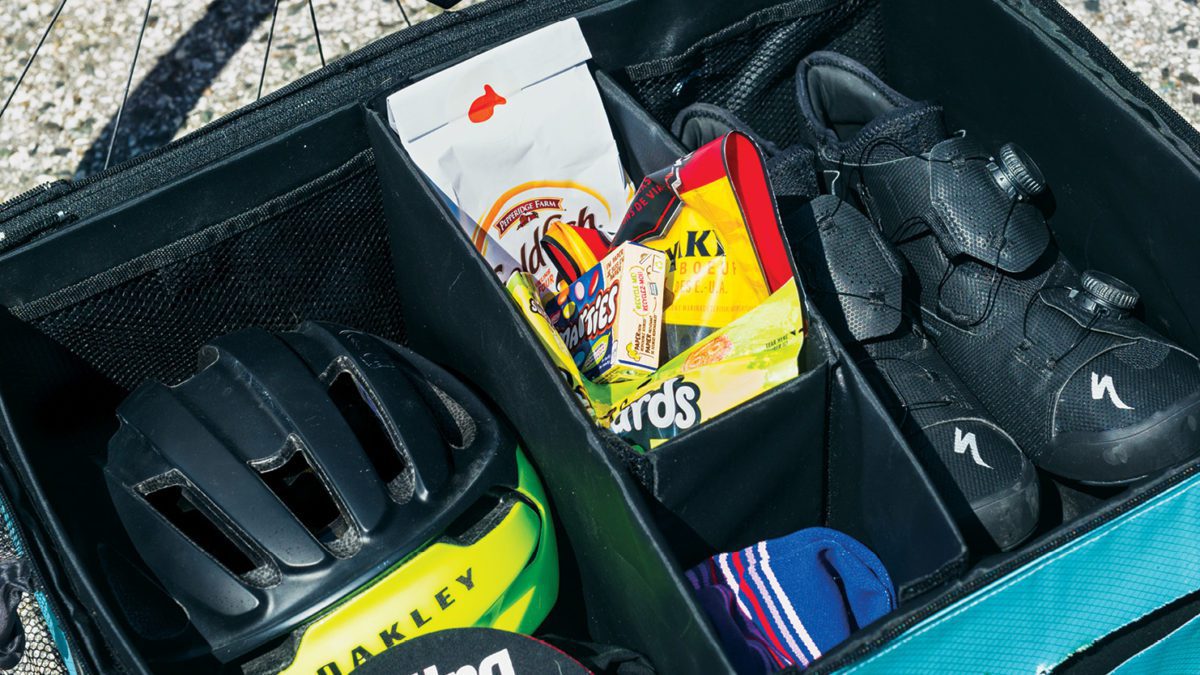Alternative fuel for alternative rides
Your grub can be as adventurous and fun as your routes
 Photo by:
Matt Stetson
Photo by:
Matt Stetson
by Cheryl MacLachlan
After a DNF at a 160-km mountain bike race, Reg Peer changed up what he ate on long rides. “The combination of heat stroke, a broken hand and improper nutrition left me sad, sitting in a lawn chair at 3 a.m., wondering who I was and how I got there,” the rider from Sault Ste. Marie, Ont., says. After dropping out of the self-supported race with 30 km left, Peer found the experience prompted him to open his mind – and stomach. “Throughout the race, locals set up feed zones with bacon, steamed potatoes, doughnuts, jerky, chips, pickle juice, ham-and-cheese sandwiches, and waffles with peanut butter and Nutella,” Peer says. “The following year, I went back and changed up my nutrition. I tucked a chicken burrito into my jersey pocket, had some teriyaki beef jerky, a sleeve of Oreos, a few Snickers and even a can of beer.” He finished the race and hasn’t stopped fuelling alternatively since. “Now when I go out for a long ride, I take pretty much whatever is in the fridge.”
For cyclists expanding the types of riding they do, including fastest known time attempts, bikepacking trips, rail-trail adventures and the like, there’s no better time to branch out in the fuel department. Here are some reasons – and ideas – that will have you stuffing your jersey pockets with different foods.
According to Andrea Docherty, registered dietitian and sports nutritionist in Windsor, Ont., engineered nutrition products aren’t inherently better than “regular” food. “They both have pros and cons, but one isn’t necessarily superior,” she says. The important thing is to have a nutrition strategy.
“When you ride longer than 60 to 90 minutes, make sure you’re taking in some fuel and bringing a water bottle,” Docherty says. “Consume carbohydrates to maintain your glycogen and blood sugar. On even longer rides, make sure you’re eating some protein and fat to sustain you longer and to fight hunger.” She recommends 30 to 60 g of carbohydrates hourly, increasing that if you ride all day. Make sure to drink intentionally, too. “On long rides, have a hydration mix or sports drink, maybe homemade, that contains some electrolytes to replace those lost through sweat,” Docherty says.
Stroopwafels, Pop-Tarts and various candy bars (factor in “meltability,” though) fill the pockets and bellies of alternative eaters. Homemade cookies or rice cakes are popular choices, too. Docherty has some dietitian-approved suggestions to try. “You could bring potatoes with salt, a sandwich, wrap or bagel with peanut butter and honey or jam, or maybe even switch things up and use pancakes or waffles instead of bread for your sandwich.”
When it comes to replacing sports nutrition products more directly, Docherty suggested making energy bars using oats, honey or maple syrup, nut butter and dried fruit. Consider lower-fibre baby-food pouches or applesauce tubes as a swap for gels. In place of chews, dried fruit provides concentrated calories and some potassium – just don’t overdo it (because fibre). Candy can work as long as you get electrolytes elsewhere. “You can eat jujubes or gummy bears, but since you may not get electrolytes, get those from other sources such as pretzels or crackers,” Docherty says.
Some athletes’ dedication to gels, chews and bars comes down to portability. If that’s your only barrier, consider making alternative fuel more convenient by pre-cutting it into bite-size pieces. Or, give yourself permission to do what sometimes feels unthinkable. “You probably won’t want to, but you’ll be able to keep going farther if you take a little time to stop and fuel your body properly,” Docherty says. Again, your nutrition approach needn’t be all or nothing. Sports foods can fill a gap when you’re tired of eating or drinking.
Reg Peer’s fridge-raiding approach to ride grub not only fuels his rides, but those of others. Peer is the co-founder of Red Pine Tours, which helps people discover the riding in the Sault Ste. Marie area. Normal food features in his tours and does more than top up cyclists’ reserves. The fuel actually helps to make cycling more accessible. “The cycling world can be intimidating. We want to try to break that stigma with a fun time out in the saddle,” Peer says. “We think there’s no better way to do that than stopping for a coffee made with locally roasted beans or hand-cut fries and a hotdog.” If that outlook is not reason enough for a butter-tart break on your next ride, what is?
This story originally appeared in the October/November 2021 issue of Canadian Cycling Magazine
